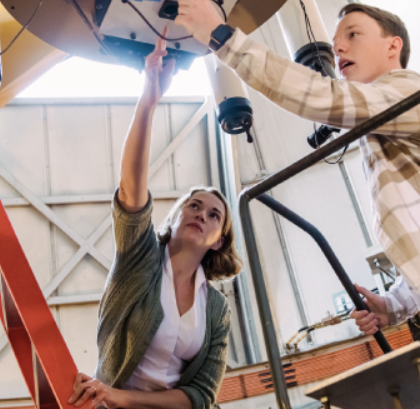The UMBC Observatory was built at the turn of the century in 1999-2000 as a focal piece of the UMBC Physics Building. The main (atmospheric physics) research goals for the observatory represented a false-start for the facility since the lead researcher left the university before it could be used. With no dedicated funding through grants, the instrumentation in the facility fell out of maintenance and modernity over the next decade. In 2013, the Observatory Team was established by Dr. Susan Hoban (now retired) and now Observatory Director Roy Prouty to develop and execute the new mission of the UMBC Observatory: to support research, public outreach, and the UMBC Astronomy Club. This work was generously supported by the Center for Space Science Technology, a research center at UMBC funded by tasks under the CRESST II cooperative agreement between a consortium of universities (including UMBC) and NASA Goddard Space Flight Center. However, the work lacked direction that could be provided by clear research goals.
Such goals were provided by Dr. Eileen Meyer and Dr. Bill Sparks (SETI) as the prospect of novel spectro-polarimetry measurements they believe our telescope is capable of supporting. Dr. Bill Sparks (as PI) as well as Dr. Meyer and Director Prouty have submitted proposals to the NSF and NASA to conduct polarimetry observations with new polarimeters, and co-authors on those proposals are from SETI, MIRA, and UNSW in Australia. The proposed new polarimeters include a new type of spectropolarimeter (PICSARR [1]) and some other prototypes being explored by the Astronomical Polarimetry (AstroPol) research group.

In January 2022, the College of Natural and Mathematical Sciences (CNMS) at UMBC generously approved seed funding to modernize the observatory and develop polarimetry equipment to be used on the telescope. In concert with the Observatory Director, Roy Prouty, Dr. Eileen Meyer established the AstroPol research group to work alongside the Observatory Team. In addition to the CNMS funding, other funding sources include the UMBC Office of the VP for Research via the START Program [2] as well as a SURE Award [2], and a Merck Fellowship.
The modernization project comes in three forms, (1) the modernization of various motors, (2) the modernization of the autoguiding system, and (3) the modernization of the control system.
Motors
The UMBC Observatory is filled with a myriad of moving parts. These parts rely on motors in order to make desired movements. An important part of the modernization process is to make sure the motors being utilized are in good shape, and that the ones that aren’t are either repaired or replaced. Read more about this work here.
Autoguiding
Stars in the night sky–if viewed long enough–will seem to have moved from their initial positions. This is due to the movement of the Earth rather than the stars themselves. Stationary observation of stars over a long period of time becomes unsustainable as telescope images do not produce viable images. Luckily, the main telescope has both tracking and autoguiding systems that our teams will be working to modernize and maintain for future scientific observations. Read more about this work here.
Control Systems
A new Dell XPS workstation has been set up in order to run all telescope operations. Replacing the older computer with a new one in order to send commands to the telescope through an EXCOM/TCP/IP interface. Read more about this work here.
[1] Jeremy Bailey, Daniel V Cotton, Ain De Horta, Lucyna Kedziora-Chudczer, Om Shastri, PICSARR: high-precision polarimetry using CMOS image sensors, Monthly Notices of the Royal Astronomical Society, Volume 520, Issue 2, April 2023, Pages 1938–1949, https://doi.org/10.1093/mnras/stad271
[2] https://research.umbc.edu/internal-funding-opportunities/